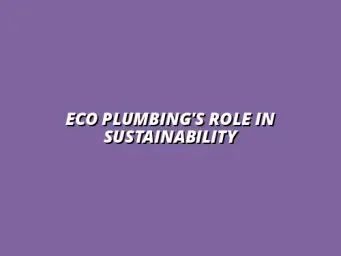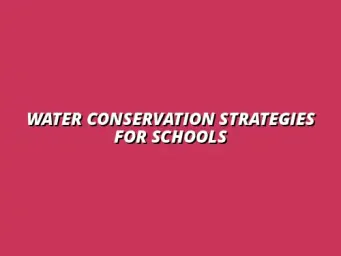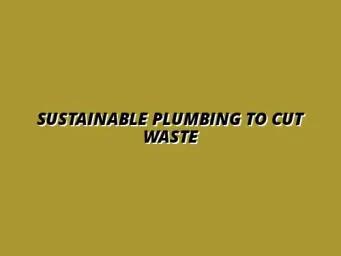Understanding the Importance of Water Conservation in Commercial Buildings
Water conservation in commercial buildings is becoming increasingly crucial as companies recognize the impact of water usage on both their operations and the environment. By implementing effective conservation practices, businesses can not only reduce their ecological footprint but also realize significant economic benefits. It’s essential to understand why these strategies matter, both for the bottom line and for sustainable living. Regular plumbing maintenance, as described in this helpful guide on plumbing inspection frequency, can significantly reduce water waste.
When companies prioritize water conservation, they contribute to a larger movement towards sustainability. This shift helps protect valuable water resources and supports community efforts to combat the effects of climate change. The adoption of water-saving measures can also enhance a business's reputation, showcasing a commitment to responsible stewardship. Simple daily changes, like those suggested in this article on reducing water waste, can make a big difference.
Economic Benefits of Implementing Water-Saving Strategies
Implementing water-saving strategies in commercial buildings can lead to impressive economic gains. Companies that adopt these practices often notice a significant reduction in their utility bills, directly impacting their profitability. Additionally, water-efficient systems can enhance the overall operational efficiency of the building, saving both time and resources. Efficient water heater maintenance, as detailed in this article on maintaining your water heater efficiently, can further reduce costs.
Furthermore, the initial investment in water-saving technologies can yield substantial long-term financial returns. By reducing water consumption, businesses can lower their expenses over time, ensuring a solid return on investment (ROI). This creates an opportunity to allocate those savings to other areas of the business, such as employee development or innovation.
Cost Reduction through Water Efficiency
One of the most immediate benefits of water efficiency is the reduction in costs associated with water usage. Businesses can save money through various strategies, including:
- Installing low-flow faucets and showerheads.
- Using water-efficient toilets.
- Optimizing irrigation systems for landscaping.
- Regularly maintaining plumbing to prevent leaks.
By focusing on these cost-saving measures, businesses can see a rapid decrease in water bills while also enhancing their overall sustainability efforts!
Long-term Financial Returns on Water-Saving Investments
Investing in water-saving technologies not only brings immediate savings but also leads to long-term financial benefits. The depreciation of water infrastructure can cost companies significant amounts over time. Therefore, investing in efficient systems is a proactive approach that pays off through:
- Lower operational expenses.
- Increased property value.
- Enhanced market competitiveness.
Focusing on water conservation now will not only ensure a healthier environment but also secure a financially stable future for businesses.
Environmental Impact of Water Conservation
The environmental advantages of water conservation are profound. By reducing water usage, businesses can significantly minimize their carbon footprint. This is crucial in addressing climate change, as water systems often require energy for pumping, treatment, and distribution. Addressing drainage issues promptly, as outlined in this guide on unblocking a sink, prevents water waste and potential damage.
Moreover, conserving water helps protect vital ecosystems that rely on natural water sources. Every drop saved contributes to healthier rivers, lakes, and wetlands, which support biodiversity and maintain ecological balance. Companies that implement water conservation strategies play a pivotal role in sustaining the natural environment!
Reducing Carbon Footprint through Water Management
Water conservation directly correlates with decreased energy consumption, making it a key strategy for reducing carbon footprints. Businesses can achieve this through various methods:
- Utilizing energy-efficient water heaters.
- Implementing rainwater harvesting systems.
- Adopting smart irrigation technologies.
Not only does this support a more sustainable future, but it also helps businesses align with global initiatives aimed at reducing greenhouse gas emissions.
Contributing to Sustainable Development Goals
By conserving water, businesses can contribute to several Sustainable Development Goals (SDGs) established by the United Nations. These goals aim to promote sustainable practices across various sectors. Specifically, water conservation aligns with:
- SDG 6: Clean Water and Sanitation.
- SDG 12: Responsible Consumption and Production.
- SDG 13: Climate Action.
Engaging with these goals not only enhances a company’s public image but also fosters a commitment to broader social responsibility. For commercial plumbing needs in Selly Oak, Birmingham, consider contacting a reputable local plumber.
Addressing Common Challenges in Water Conservation Efforts
When it comes to water conservation in commercial buildings, there are several challenges that organizations often face. These can range from cultural resistance to the financial burden of implementing new systems. Recognizing these challenges is the first step toward developing effective strategies that can lead to successful water conservation initiatives!
One of the biggest obstacles is often the resistance to change from employees and management alike. People can be set in their ways, and changing established routines can be a tough sell. However, addressing these concerns can help pave the way for a more water-efficient future.
Overcoming Resistance to Change in Organizations
To successfully implement water-saving initiatives, it's crucial to engage employees and get their buy-in. When employees understand the importance of water conservation, they're more likely to participate actively in these efforts. Additionally, involving them in the planning stages can foster a sense of ownership and commitment.
Creating a culture of conservation is equally vital. By making water-saving a core value of the organization, you can encourage all employees to prioritize it in their daily tasks. Here are some strategies to build this culture:
- Provide training sessions on water conservation practices.
- Reward teams or individuals for achieving water-saving milestones.
- Share success stories within the organization to inspire others.
Engaging Employees in Water-Saving Initiatives
Engaging employees can take various forms, from simple educational programs to more complex involvement in decision-making. This engagement can positively impact both morale and overall effectiveness in conservation efforts. Companies might consider forming water conservation committees to foster ongoing dialogue and innovation!
In addition, establishing regular communications—like newsletters or meetings—can keep water-saving initiatives at the forefront of everyone's mind and encourage continuous participation. Regular updates help everyone stay informed about the progress being made!
Creating a Culture of Conservation
Creating a strong culture of conservation requires commitment from all levels of the organization. Leadership must demonstrate their commitment by actively participating in water-saving activities and showing their support for initiatives. Consider the following steps to create this culture:
- Incorporate conservation goals into company objectives.
- Celebrate achievements related to water-saving initiatives.
- Encourage open feedback about conservation practices and policies.
Dealing with Initial Costs of Water-Saving Installations
A common misconception is that water-saving installations are too expensive for commercial buildings. While there may be initial costs, it’s important to see these as an investment rather than an expense. Over time, these projects often pay for themselves through significant savings on water bills and maintenance costs.
Exploring various financing options can make these projects much more feasible. Understanding the available funding can drastically reduce the financial burden and make the switch to water-saving technologies much smoother.
Exploring Financing Options for Water Efficiency Projects
There are numerous financing options available to businesses looking to invest in water efficiency. These options can help alleviate the strain of upfront costs, making it easier for organizations to adopt water-saving technologies. Here are some financing options to consider:
- Government grants and incentives.
- Low-interest loans specifically for water efficiency projects.
- Partnerships with local utilities that provide rebates.
Evaluating the Return on Investment in Water Savings
While upfront costs can deter some organizations, the return on investment (ROI) for water-saving measures typically justifies the initial expenditure. Calculating potential savings can help businesses understand the long-term benefits of water conservation. Factors to consider when evaluating ROI include:
- Reduced water bills.
- Lower maintenance costs for plumbing fixtures.
- Potential increase in property value.
By focusing on these aspects, businesses can better appreciate the financial advantages of implementing water-saving technologies!
Insights and Resources for Effective Water Management
Successful water conservation requires more than just action; it demands a comprehensive understanding of available resources and regulations. Organizations must stay informed about local laws and incentives that can aid their efforts. This knowledge can not only provide guidance but can also uncover financial assistance opportunities as businesses strive for sustainability.
Additionally, having a solid grasp of the available resources can lead to better planning and implementation of water-saving strategies. By utilizing these insights, organizations can maximize their water management efforts, ensuring they achieve their conservation goals!
Understanding Local Regulations and Incentives
Every region has its own set of regulations and incentives regarding water conservation. These guidelines can significantly impact how businesses approach water-saving initiatives. Researching these regulations before starting a project is essential to ensure compliance and gain maximum benefits.
Familiarizing yourself with local laws can help identify potential benefits, such as tax breaks or grants. Here are some steps to ensure your business is making the most of available regulations and incentives:
- Contact local government offices for up-to-date information.
- Consult with industry groups that specialize in water conservation.
- Review state and federal programs that support water-saving technologies.
Researching Water Conservation Regulations for Businesses
Understanding regulations can also help businesses avoid potential fines or penalties. By conducting thorough research, organizations can ensure they are aligning their practices with legal requirements while also taking advantage of incentives. A good starting point is to check with:
- Local water authorities.
- Industry-specific associations.
- Environmental protection agencies.
Identifying Grant Opportunities for Water Efficiency Projects
Grants can be a fantastic financial resource for businesses looking to improve their water management strategies. Numerous organizations offer grants specifically for water conservation projects, which can help offset costs. To identify these opportunities, businesses should:
- Search online databases for available grants.
- Network with other businesses to share information about funding.
- Stay engaged with local environmental groups that may provide leads.
Frequently Asked Questions about Water-Saving Tips
As businesses embark on their water conservation journey, several common questions arise. Addressing these frequently asked questions can help provide clarity and direction for organizations looking to save water effectively. Understanding the answers can lead to better decision-making!
Two common queries include:
- How can businesses measure their water usage effectively?
- What are the most significant changes businesses can implement to save water?
How can businesses measure their water usage effectively?
Measuring water usage is crucial for identifying areas for improvement. There are various methods and tools available, such as:
- Installing water meters to track consumption.
- Conducting regular water audits to assess usage patterns.
- Using software to analyze water use data and identify trends.
What are the most significant changes businesses can implement to save water?
Implementing effective water-saving measures can greatly reduce consumption. Some impactful changes include:
- Upgrading to water-efficient fixtures and appliances.
- Implementing rainwater harvesting systems.
- Educating staff about conservation practices.
Future Trends in Water Conservation for Commercial Properties
Water conservation is evolving, and staying ahead of emerging trends can significantly benefit your organization. By understanding these trends, businesses can position themselves as leaders in sustainability and efficiency, making a positive impact on both the environment and their bottom line!
While the path to effective water management may have its challenges, it also holds promising opportunities for innovation. Embracing these changes can lead to a brighter, more sustainable future for commercial properties.









